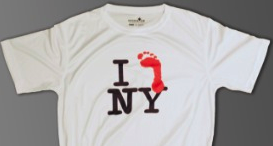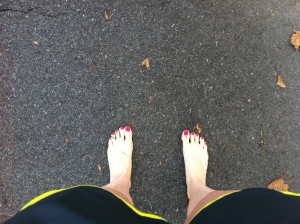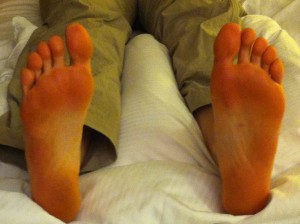Last Saturday morn ing, my husband and I made our way to Battery Park, unsure of exactly what we’d find.
ing, my husband and I made our way to Battery Park, unsure of exactly what we’d find.
We’d flown to New York City for the 2nd Annual NYC Barefoot Run.
Hands-On Coaching and Demonstrations
Anchored by the Vivo Barefoot and VitaCoco tents, the lawn area was full of mostly barefoot folks participating in several clinics. We jumped right in to a presentation by Mark Cucazella and Jay DiCharry, Director of the SPEED Clinic at the University of Virginia’s Center for Endurance Sport. It was fascinating, and I learned a ton of practical information in just a short time.
DiCharry focused on the basic flexibility and strength needed to run barefoot, noting that most desk-jockeys will need to ease into it. I made as many notes as possible, and then found this article in Running Times that captured his points precisely. Essentially, we need to have adequate range of motion in our ankle, big toe, calf, and achilles tendon. Single leg balance and strength is also important. [As a side note, I had to smile. Many of his recommended stretches and exercises were very familiar to me. They’re a staple component of Pinnacle Fitness bootcamps, and I’ve been practicing them regularly for nearly a year now.]
Next, we circled up with Michael Sandler. Formerly a professional cyclist and speed skater, he shared how running barefoot allowed him to get moving again after a life-threatening accident. More than anything, Sandler is a testament to the pain-free opportunity that barefoot running represents. His book on Barefoot Running (affiliate) is also an excellent resource.
Top Notch Speakers
Saturday night, we enjoyed dinner at the Seaport at Pier 17 and then settled in to the Merrell Barefoot Party. Seeing the lineup, I knew we were in for a treat. All of the speakers were fantastic. Three in particular added some significant pieces to the health puzzle I’m assembling for myself.
First, Esther Gokhale and her presentation on posture. Sharing pictures of ancient peoples from around the globe and even skeletal charts from the early 1900’s, Gokhale proposes that what we think we know about posture may be quite incorrect. She suggests we throw out the fancy office chairs (sound familiar?) and learn to align our bodies and function in sync with our design. If you’re experiencing pain anywhere, I’d strongly suggest you take a look at her Gokhale Method.
Next, Dr. Dan Lieberman, leader of Harvard University’s Skeletal Biology Lab, shared his decades of research into the biomechanics of endurance running, comparing barefoot runners to those that utilize modern shoes. Study after study demonstrated lower injury rates – and often faster times. Want to see for yourself? Watch these videos about Heel Strikes and Ground Reaction Forces.
Finally, Erwan LeCorre, founder of MovNat, connected the principles of barefoot running to breaking out of our human “zoos” in several aspects of our life. As he said, “When we take off our shoes, we’re not trying to do something, we’re trying to BE something.” Personally, this is a movement that I’m going to explore. Going beyond our food and our fitness, living naturally can be a lifestyle, even in our urban environments.
Running in my Birthday Shoes
 Throughout the weekend, lots of folks had talked about the distinctions between running completely barefoot and running in minimalist shoes. Other than on the beach, I’ve never run in less than my Vibrams. I debated it all morning.
Throughout the weekend, lots of folks had talked about the distinctions between running completely barefoot and running in minimalist shoes. Other than on the beach, I’ve never run in less than my Vibrams. I debated it all morning.
When the time came, I knew I’d regret not giving a try – so off they came.
I’d be running in my birthday shoes – on asphalt, for the first time.
Turns out, they held up just fine.
I completed three laps on our just over 2 mile course around Governor’s Island, never having any unusual pain or discomfort. Eventually, they were tender along the roughest patches of asphalt. (For my 4th lap, I put the Vibrams back on.)
The Aftermath
Even I wondered what my feet would look like afterwards. Certainly they were dirty. But would they be scratched up? Had any pebbles or glass fragments broken the skin?
Nope. No major damage at all, just a little red and puffy on my forefoot. After just a few hours, the tenderness was completely gone.
So, what’s next?
As I headed out the door for my run this morning, I left my Vibrams inside. Reaching the end of my driveway, I noticed a large pile of glass and the darkness of an early morning. A little spooked, I went back inside and put shoes on. But throughout the run, I was monitoring the ground, looking for anything that might seem unsafe. Other than that first patch, I didn’t see a thing.
Next time you see me out logging some miles, there’s a good chance I’ll be using just the shoes God gave me.








Kendra,
Thanks for the plug. Sounds like you were in good company and had a good experience. Let the barefoot movement continue.
Thanks! You definitely prepared me well.